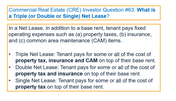How I think about REIT balance sheets
To me, the most relevant factors are the following:
1) LTV or Loan to Value - this is the total amount of debt relative to the total value of the properties owned by the REIT.
2) Structure of debt - recourse vs. non recourse
3) Term to maturity & covenants
4) Outlook for NOI - LTV sensitivity given different levels of NOI/cap rates
Here we use the Net Operating Income (akin to EBITDA) of the REIT. Call this (A).
Then we select a multiple. The multiple is the inverse of the cap rate - to use California multifamily as an example, 22-25x is a reasonable multiple based on private market transactions which =1/0.04 or 1/0.045 (because market cap rates are 4-4.5%). Let's call this (B).
Multiplying A * B (total property value = NOI/cap rate) gives the total value of all of the properties in the company's portfolio. Let's call this (C).
We then find the company's total debt (from 10Q or even better find it in the quarterly supplemental) - Call this (D).
Lastly, we divide D by C. This gives the Loan to Value (LTV).
For the big 3 California apartment REITs, ESS/AVB/EQR, I get a ratio of 22-29%. Is this good/safe? Well let's see....
We then must determine the reasonableness of the Loan to Value. For the California apartment REITs, I compare the LTVs of the public REITs vs. what I see in the private market.
Private market apartment building investors typically use much more debt than the big 3 REITs (ESS, EQR and AVB) - usually in the 60-75% range.
So we can see that the balance sheets/debt levels of the big 3 apartment REITs are very safe/conservative. We don't have to worry about dividend cuts or equity issuances. In fact this has played out in 2020 as the big 3 California apartment REITs not only didn't cut their dividends but
1) grew their dividends Year over Year by 4-6%
2) ESS/AVB initiated share buybacks - this will give each shareholder a greater proportional interest in each apartment building and each apartment unit without having to buy new shares!!
DEBT STRUCTURE
The structure of the debt is also important. It isn't super meaningful when we consider the West Coast apartment REITs which are very under-leveraged as I highlighted above. But for entities using higher leverage, the debt is typically done using a non-recourse structure whereby the debt is only attached to the property (property is in a separate legal entity - the debt is at that legal entity with no recourse to the parent/holding company).
Clipper (CLPR - full writeup here) which has an LTV of ~53% has structured its balance sheet in this fashion. The debt on Clipper's properties has no recourse to the parent company -i.e. if a property gets into trouble, Clipper can simply forgo its shareholders' equity in that property.
While people mistakenly view CLPR as being highly leveraged, the reality is that Clipper could pay a ~$2 special dividend today (1/3 of stock price at current quote; the cash at holding company) and still own all of its properties (and keep paying $0.38 per share in annualized dividends).
In my assumed Equity Residential recap transaction, I assume that EQR would use more expensive (2.7% - consistent with what we've been hearing from private market/debt folks) vs. the much less expensive unsecured debt because of the higher leverage levels (75% vs. ~25% presently) in the re-capitalization transaction. Note 75% LTV is in-line with private market capital structures which are able to get debt in the 2.6-2.8% range currently. As I may have mentioned, when thinking about multifamily, because just 5% trades publicly as REITs, we must look to the PRIVATE MARKET because it is the REAL market.



